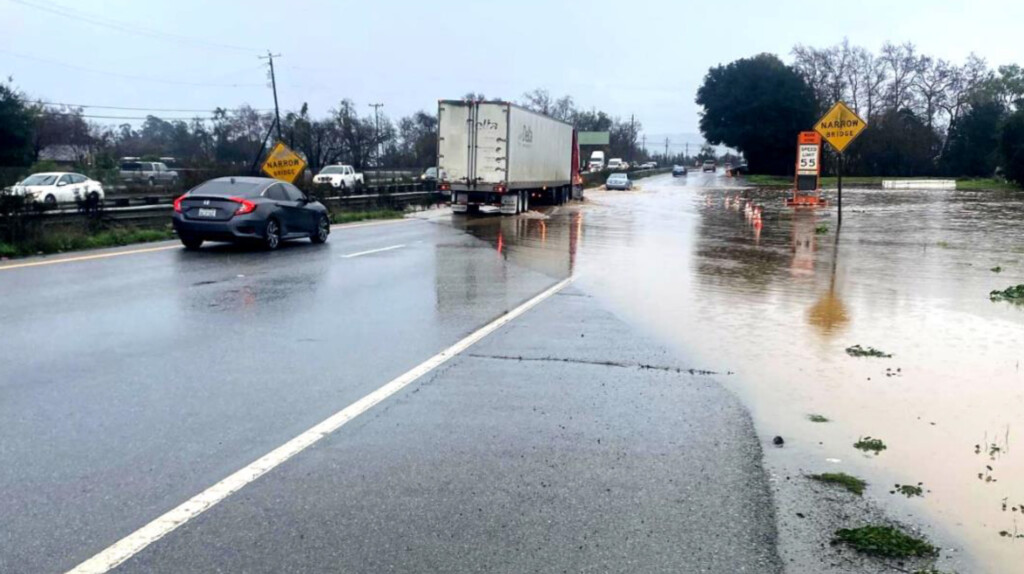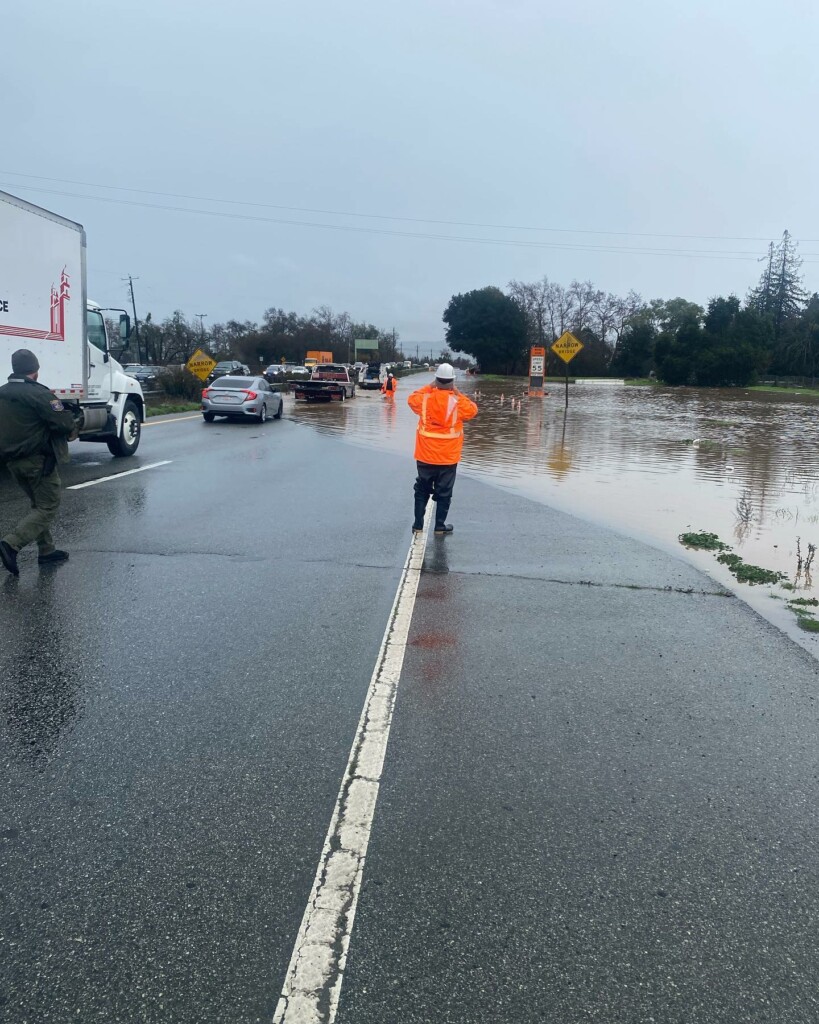Main story: Gilroy residents survive gauntlet of severe storms
‘Atmospheric rivers’ fill state reservoirs, reducing impact of years of drought
![]()

Curious people check out the major flooding at Miller’s Crossing in Gilroy’s Christmas Hill Park. Torrential rains have battered the South Valley region since late December.
Photo by Marty Cheek
By Marty Cheek and Robert Airoldi
Gilroy residents faced the aftermath of a relentless series of torrential storms that pounded California starting in late December, causing widespread damage to homes, businesses and infrastructure.
 Another storm hit Northern California Friday, Jan. 13. Meterorologists expected rain through Monday, Jan. 16.
Another storm hit Northern California Friday, Jan. 13. Meterorologists expected rain through Monday, Jan. 16.
Clean-up of statewide damage from the “bomb cyclone” storms could exceed $1 billion, according to California’s emergency agency.
Gilroy received 13.6 inches of rain from Dec. 24 through Jan. 11. This is more than half the annual average. An additional 2 inches is expected through Monday, Jan. 16, said Sarah McCorkle, meteorologist with the National Weather Service in Monterey.
Since New Year’s Eve, six storms have battered California.
“As far as getting rain the past two weeks, that’s not been abnormal, but it’s so many back to back to back that is the unusual part, for sure,” she said.
The system coming in the week of Jan. 15 won’t produce as much rain as previous storms, perhaps a .25 of an inch, she said.
The deluge is helping the state deal with its water shortage.
“We are no longer in an ‘extreme’ drought but still in a ‘moderate’ drought,” she said. “We still have a ways to go but the recent storms have definitely improved the situation.”
The gauntlet of powerful “atmospheric river” storms — corridors of highly concentrated water vapor moving quickly above the Pacific Ocean — turned South Valley streets into rivers and farm fields into lakes. Downed trees, road closures and power outages impacted sections of South Valley, leaving residents to pick up the pieces and make repairs as they struggle to recover from the severe weather.
 The California Highway Patrol closed U.S. 101 south of Gilroy for six hours Jan. 9 after overflow from Uvas Reservoir spilled over the dam into Uvas Creek near Mesa Road. Downstream, muddy knee-deep water stranded several cars. The massive traffic jam that afternoon sent vehicles into side streets in Morgan Hill and Gilroy, causing one non-injury accident of several cars on Monterey Road south of San Martin.
The California Highway Patrol closed U.S. 101 south of Gilroy for six hours Jan. 9 after overflow from Uvas Reservoir spilled over the dam into Uvas Creek near Mesa Road. Downstream, muddy knee-deep water stranded several cars. The massive traffic jam that afternoon sent vehicles into side streets in Morgan Hill and Gilroy, causing one non-injury accident of several cars on Monterey Road south of San Martin.
One Hollister resident told us he left San Martin at 3 p.m. that day and got home three hours later.
Video from the KPIX CBS News helicopter showed several homes near the 101/25 overpass, including the historic Calhoun Ranch home, submerged to the first floor level. Only the roofs could be seen of several parked vehicles outside the houses.
During December and half of January, the storms added about 4.7 million acre-feet of water to California’s supply. That’s the yearly use of 23 million people. In the Sierra Nevada mountain range, the snow-pack reached a two-decade record of more than 226 percent of normal, helping to put what climate scientists consider a serious dent in the drought with the spring melt.
The usually dry Uvas Creek turned into a raging river flowing through Christmas Hill Park Tuesday Jan. 10, attracting a number of Gilroy residents who gathered along the edges and took photos and videos of the rapid torrent.
Valley Water has been closely monitoring the flooding of county creeks and the amount of water filling of the 10 reservoirs it manages. They worked with cities and local jurisdictions on flood watches to prepare people for possible evacuations. Valley Water distributed more than 100,000 sandbags in the county during the storms, including sites in Gilroy and Morgan Hill.

Northbound 101 on Jan. 9, 2023, during the flooding of the south Gilroy farmland. Photo courtesy CHP
Anderson Reservoir, now undergoing a $1.2 billion earthquake retrofit project, is required by the federal government to be at 3 percent of capacity. With the storms, it went to 22.7 percent of capacity. Water is being drained through an outlet pipe into Coyote Creek, said Matt Keller, media supervisor for Valley Water.
“This has been unprecedented to say the least to get this much rain in such a short amount of time — to get those atmospheric rivers back to back to back,” he said. “It has been impactful to all the people in Santa Clara County and all the people in the Bay Area and California as well.”
During the summer and fall, Valley Water conducts a stream maintenance program to clean out waterways of debris and other blockages. During winter storms when creeks are high, the job can become dangerous if giant trees fall into the waterways when roots are loosened in the sediment. They must be removed to prevent potential flooding.
“That’s really a big part of the work that we do is to make sure those creeks are not seeing any blockages from the debris that goes in,” Keller said. “Mother Nature delivered quite a few storms and a lot of water into the watershed.”
As of Friday Jan. 13, at least 19 people throughout California have died from flooding and storm-related incidents. That’s more than the number who lost their lives in the state’s wildfires for the past two years.
The deaths include Kyle Doan, a 5-year-old boy in San Miguel in San Luis Obispo County. A powerful current swept him away from his mother’s arms after their truck got trapped in a flooded creek on the way to his school Jan. 9. No lives were reported lost in the South Valley.
More than 4.5 million Californians faced flood watch warnings, and thousands were displaced throughout the state. A spokesman for the California Governor’s Office of Emergency Services called the seemingly nonstop deluge “one of the deadliest disasters in the history of our state.”
President Joe Biden issued an emergency declaration Jan. 9 to support storm response and relief efforts in more than a dozen California counties.
Valley Water activated its Emergency Operations Center Dec. 31 due to heavy rainfall and flooding and provided relief operations throughout the county. Flooding occurred along San Francisquito Creek, Upper Penitencia Creek, West Little Llagas Creek and Uvas Creek.
Click HERE to view a message from Gilroy Police Chief Pedro Espinoza about public safety during the storm.
The Valley Water Board of Directors voted Tuesday, Jan. 10, to extend a countywide flood emergency declaration first signed by CEO Rick Callender on Jan. 4. This provides the agency with legal authority to take emergency action to preserve life and property.
 “This series of atmospheric rivers has greatly impacted Santa Clara County,” Valley Water Chair John L. Varela said. “Thanks to this emergency declaration being put in place before the extreme weather arrived, Valley Water did important work in our waterways that cleared out blockages and removed debris, downed trees and sediment so water could flow freely in our rivers.”
“This series of atmospheric rivers has greatly impacted Santa Clara County,” Valley Water Chair John L. Varela said. “Thanks to this emergency declaration being put in place before the extreme weather arrived, Valley Water did important work in our waterways that cleared out blockages and removed debris, downed trees and sediment so water could flow freely in our rivers.”
A large portion of Central California was in an “exceptional drought” status for the past several years, but the storms’ filling of reservoirs caused the U.S. Drought Monitor to reduce the status to “severe” and “moderate” drought.
Gov. Gavin Newsom visited Capitola Jan. 10 to assess storm damage. After meeting with local business owners along the severely damaged Capitola Wharf, he urged people to prepare for more storms through the weekend and into the middle of next week.
“We’re not out of the woods — we expect these storms to continue at least through the middle of next week with a minimum of three more atmospheric rivers hitting our state,” he said. “California is soaked and even an inch more of rain can bring catastrophic impacts like flooding and mudslides. These conditions are serious and they’re deadly and we want all Californians to be mindful and follow all guidance from local emergency responders.”
Climate scientists call California’s recent storm pattern a “precipitation whiplash.” On a historic perspective, rains in recent decades are heavier and more catastrophic at the same time droughts can last longer and be more intense. Global warming contributes to the overall heating of the atmosphere to create a higher level of variability.

